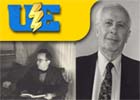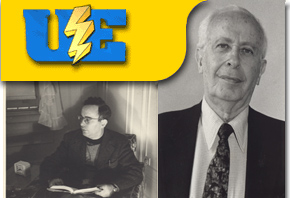
| Project
Director: Dr. Gerald Zahavi Contents
|

A Talking History Project
Nathan Spero ~ A
Life in the UE
Nathan Spero was the Research Director for the United Electrical Workers Union (UE) for thirty-nine years, from 1944 until 1983. Prior to his career with the UE, Spero worked as a statistician for the National Research Project on Productivity and Technological Change for the U.S. Department of Labor (from 1937 until 1943).
During his career in the UE, in addition to his regular duties Spero served as the co-chair of the 13-union joint committee on pensions and insurance in negotiations with General Electric and Westinghouse from 1975 through 1981. He was also intimately involved with UE convention work and was responsible for pre-convention assembly and editing of all convention resolutions. Also during his years in the UE, Spero was a member of the Department of Labor's Commission on Incentives. From 1991 to 1992 he served as the President for the New School for Social Research's Institute for Retired Professionals. Through the 1990s and until very recently, he taught math and labor history at the Manhattan branch of Queens College in New York City.
Spero's publications include the War Labor Board's Brief on Equal Pay for Women on Jobs of Comparable Worth, various United Electrical Workers Annual Reports on the economic situation in the electronics industry, and industrial pamphlets on such topics as ERISA, Social Security, and Occupational Hazards.
Between 1994 and 1996, Jane Latour interviewed Nathan Spero about his life, his work, and the history of the UE. The interviews focused on the 1930s through the 1980s. These interviews, as well as supplementary documentary materials on Spero's life and career are included here.
|
|